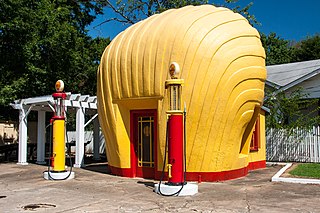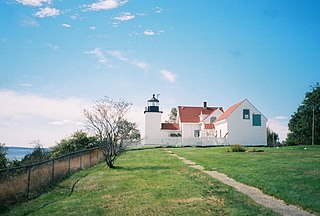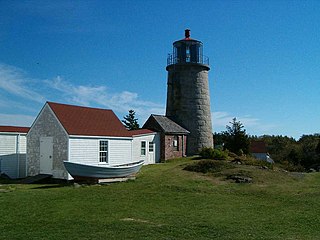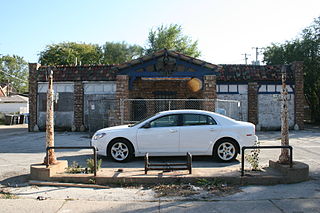
Tower station, often called the Tower Passenger Depot, is a former passenger railroad depot in Tower, Minnesota, United States, that is listed on the National Register of Historic Places. Built in 1916 by the Duluth and Iron Range Railroad, it provided passenger train service until 1951. It currently operates as the Tower-Soudan Historical Society Center museum.

The Shell Service Station in Winston-Salem, Forsyth County, North Carolina, was a filling station constructed in 1930 following a decision in the 1920s by the new local Shell distributor, Quality Oil Co., to bring brand awareness to the market in Winston-Salem. The building is an example of representational or novelty architecture and was listed on the National Register of Historic Places on May 13, 1976. It is located in the Waughtown-Belview Historic District.

Ambler's Texaco Gas Station, also known as Becker's Marathon Gas Station, is a historic filling station located at the intersection of Old U.S. Route 66 and Illinois Route 17 in the village of Dwight, Illinois, United States. The station has been identified as the longest operating gas station along Route 66; it dispensed fuel for 66 continuous years until 1999. The station is a good example of a domestic style gas station and derives its most common names from ownership stints by two different men. North of the station is an extant outbuilding that once operated as a commercial icehouse. Ambler's was the subject of major restoration work from 2005–2007, and reopened as a Route 66 visitor's center in May 2007. It was added to the U.S. National Register of Historic Places in 2001.

The U-Drop Inn, also known as Tower Station and U-Drop Inn and Tower Café, was built in 1936 in Shamrock, Texas along the historic Route 66 highway. Inspired by the image of a nail stuck in soil, the building was designed by J. C. Berry. An unusual example of art deco architecture applied to a gas station and restaurant, the building features two flared towers with geometric detailing, curvilinear massing, glazed ceramic tile walls, and neon light accents. It has traditionally held two separate business: "Tower Station", a gas station on the western side, and the "U-Drop Inn", a café on the eastern side. Though it has passed hands several times in its history, the building has consistently housed the same types of businesses it was originally constructed for.

The Fort Point Light, or Fort Point Light Station, is located in Fort Point State Park, in Stockton Springs, Maine. A lighthouse at this point has served as an active aid to navigation since 1835; the present lighthouse dates to 1857, and is listed on the National Register of Historic Places.

Wadham's Oil and Grease Company of Milwaukee was a chain of filling and service stations that operated in the early 20th century and was headquartered in Milwaukee, Wisconsin. The company's refinery was in Indiana. The company was headed by Harger W. Dodge, who assumed leadership from his father-in-law in 1916. Dodge saw the potential in offering a convenient way for automobile owners to fill their cars with gasoline. He built off-street filling stations with underground tanks for the gasoline and electric pumps to dispense it. Wadham's was purchased by Vacuum Oil Company in 1930. Vacuum Oil was then acquired by Socony, which later became Mobil.

Art's Auto is a historic former service station at 5–7 Lonsdale Avenue in Pawtucket, Rhode Island. It is a single-story brick structure with a flat roof and a series of towers capped by pointed roofs. It was built as an automotive service station in 1927–28 for Arthur Normand at a time when gasoline producers competed, in part, by the shape and style of their service stations. This station is one of two stations known to survive from this period in the state. Its front facade has a dramatic presentation, with square towers topped by pyramidal roofs at the corners, and a projecting round bay in the center topped by a conical roof, with windows arrayed around the bay and on its flanks. The building is currently used as an office for Anchor Financial. Art's Auto was listed on the National Register of Historic Places in 1978.

The Bailey Farm Windmill is an historic windmill on Maine State Route 16, north of the village of North Anson, Maine. Built in 1905, it is an architecturally distinctive local landmark, with an octagonal frame and a copper-domed roof. It was listed on the National Register of Historic Places in 1988.

The Colonial Beacon Gas Station is a historic gas station at 474 Main Street in Stoneham, Massachusetts. It was built c. 1922 by the Colonial Oil Company to be a flagship station in their chain of filling stations. The concrete and stucco building was designed by the Boston firm of Coolidge & Carlson. It has two main sections: an octagonal section that once served as a drive-through filling area, and a rectangular service area to its left. Corinthian columns originally supported the octagonal section; these have since been covered over or replaced. The octagonal section is topped by a round dome, at whose apex is a small pillared section that was once topped by a grillwork globe that housed a light. This light, when illuminated, became the beacon which gives the station its name. The service area and pumping bay have a band of starburst panels that run along the top of the flat roofed service area and around the base of the pumping area dome.

Monhegan Island Light is a lighthouse on Monhegan Island, Maine. It was first established in 1824. The present structure was built in 1850. It was Alexander Parris's last significant design. It is the second highest light in Maine — Seguin Light, with a 6-foot taller tower, is 2 feet higher in elevation. It was listed on the National Register of Historic Places as Monhegan Island Lighthouse and Quarters on May 7, 1980, reference number 80000239.

Perkins Island Light is a lighthouse on the Kennebec River in Maine. It was established in 1898, as part of a major upgrade of the river's lights — the Doubling Point Light and the separate Range Lights on the point, Perkins Island Light, and Squirrel Point Light were all built at the same time. It was listed on the National Register of Historic Places as Perkins Island Light Station in 1988.

Prospect Harbor Point Light is a lighthouse on Prospect Harbor Point, which divides Sand Cove from Inner Harbor at the head of Prospect Harbor on the southern shore of Gouldsboro, Maine. Also known as Prospect Harbor Light, it was first established in 1850. The present structure was built in 1891. It was listed on the National Register of Historic Places as Prospect Harbor Light Station in 1988.

The Boesch, Hummel, and Maltzahn Block, also referred to as the Boesch-Hummel-Maltzahn Block, is an historic building in New Ulm, Minnesota, United States. The private commercial structure was placed on the National Register of Historic Places (NRHP) on December 31, 1979. The building is significant for the extensive features of the front facade as compared to the other "Main Street" buildings in New Ulm and surrounding communities.

Freitag's Pure Oil Service Station is an automobile service station styled like an English cottage and built in Monroe, Wisconsin in 1935 by the Pure Oil Company. It was added to the National Register of Historic Places in 1980.

The Four Nineteen Building is a historic gas station building located at 419 E. 83rd St. in the Chatham community area of Chicago, Illinois. The station was built in 1928 by William D. Meyering and David L. Sutton, two local real estate businessmen. The station is an example of the Domestic style of gas station architecture, in which stations were designed to resemble small houses. A wooden canopy supported by brick piers covers the building's front entrance and two garage bays extend from either side, making the station part of a subtype of the Domestic style appropriately named "House with Canopy and Bays". The station's walls are built with clinker bricks laid in a skintled pattern, a combination of two Chicago construction innovations. Clinker bricks were heated at higher temperatures than standard bricks, making them swollen, dense, and differently colored; the bricks were generally discarded until the 1920s, when Chicago architects began to build with them. The skintled pattern of brickwork consisted of rough and irregular bricklaying in which bricks stuck out of and into the wall at different angles. The building's parapet roof is tiled with multicolored Mission style clay tiles, which were thought to pair well with skintled walls by architects of the era. Gas stations constructed from the 1930s onward generally had more functional designs, and as of 1999, the Four Nineteen Building was one of only sixteen Domestic-style gas stations remaining in Chicago and one of three with both a canopy and bays.

The R. W. Lindholm Service Station is a service station designed by Frank Lloyd Wright and located in Cloquet, Minnesota, United States. Built in 1958 and still in use, it is the only station built to a Wright design during his lifetime. It was originally part of Wright's utopian Broadacre City plan and is one of the few designs from that plan that was actually implemented. The building is listed on the National Register of Historic Places.

The Huning Highlands Conoco Service Station is a historic gas station in the Huning Highlands neighborhood of Albuquerque, New Mexico. It was built in 1937 by the Continental Oil Company (Conoco) and is notable as a well-preserved example of the automobile-oriented development that shaped the city during the mid-20th century. The building was listed on the New Mexico State Register of Cultural Properties and the National Register of Historic Places in 2006.

The Spring Street Service Station, at 200 N. Spring St. in McMinnville, Tennessee, also known as Pure Oil Gas Station, was built in 1932. It was designed by Carl August Petersen with Tudor Revival style, inside and out. It was listed on the National Register of Historic Places in 2001.

The Continental Oil Company Filling Station at 35 First Ave. N. in Kalispell, Montana was a historic filling station built around 1932 which was listed on the National Register of Historic Places in 1994. It has since been demolished.























